RESOURCES
5-144000
A
B
C
D
E
F
G
H
I
J
K
L
M
N
O
P
Q
R
S
T
U
V
W
Y
Z
|
|
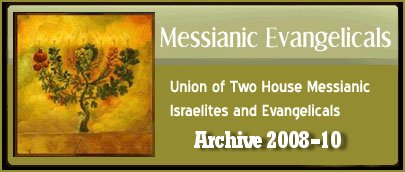
|
Questions by a Mennonite About the Holocaust
Posted by Lev/Christopher on October 4, 2009 at 4:58am
in Judaism
Part A
My uncle, Dan Bauman, with a shofar? At first glance I could have
fooled myself, but this man in Jerusalem (his clothes notwithstanding)
is no relative of mine and he represents an orthodoxy quite unlike my
own.
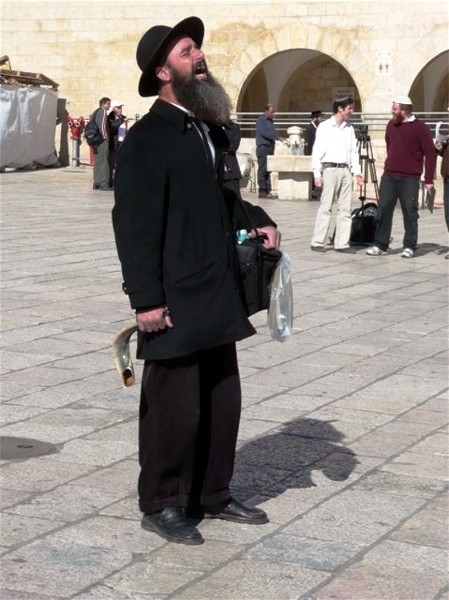
Ever since my childhood among the Orthodox Mennonites (now living
around Gorrie, Ontario) people have taken me to be Jewish. First, no
doubt, because I wear a black hat and a beard. But also, they say,
because of my facial features, and now because of my children, who are
"as Jewish as Matzah with Gefillte Fish" according to one expert on the
matter.
What do you think -- could he be right?
Could there be more to our Mennonite and Jewish connection than mere
similarities in speech (Yiddish/Schwäbisch), the plain clothes we wear,
and the places we have lived amongst each other in central and Eastern
Europe?
An old friend, a Kleingemeinde Mennonite from the Quellenkolonie in
Mexico, now living in Canada, recently sent me an article “proving”
that Mennonites are of Jewish background, and that this is “of profound
significance in our time.” In the supporting articles and on-line
booklets of his web-site, Rudy Rempel, a Mennonite from my home area in
Ontario, Canada, seeks to prove from the Bible that this is true.
A year ago, two members of the Orthodox Jewish (Lubavitcher)
congregation in Launceston, Tasmania, came up the coast, looking for
scattered members of the Diaspora in our part of the island. Just west
of here, in Smithton, they found an older Evangelical preacher who for
years has held prophecy conferences, teaching the restoration of
Israel, and the upcoming salvation of “all Israel” as J. N. Darby
taught it. He gave them an open-armed welcome, assuring them his Dutch
ancestry included some Jewish blood as well. More than that, he tried
to talk me into going that direction too. “You are Jewish, Peter,” he
kept insisting. “No matter what you say, you are definitely a Jew. I
can see it in your eyes, in your ears, in the way you talk. Who knows
where it happened, but some of your ancestors in Germany were Jewish
beyond doubt!”
Another man, who attended our meetings here at Rocky Cape for over a
year, insisted that all Anglo-Saxons (people from Germany or Great
Britain) descend from the ten lost tribes of Israel. He held to the
Glastonbury tales, to Jesus’ uncle, Joseph of Arimathea, owning copper
mines in England (where Jesus spent his summer vacations), to a
God-designed Aryan superiority and insisted that only real Israelites
(i.e. Anglo-Saxons) can be redeemed. When my adopted son, an ethnic
Mexican, married a German-speaking Hutterite girl, he stopped coming to
our meetings because we permit adultery (the Hebrew word for adultery
meaning miscegenation in his understanding of the Bible).
The story goes on and on. If you could see the passionate letters I get
on this subject, you might understand what brought me to question,
sincerely, why being Jewish, or knowing all about the Jews --
particularly their experiences during World War II -- has became the
rage of our time. (Go type, “Am I Jewish?” into your browser, for an
idea of the hundreds of thousands, if not millions of links and sites,
connected to this question.)
What does God say?
Does it matter if we are Jewish or if we are not? Or if anyone else is Jewish -- or isn’t?
Shortly after the Holocaust Museum opened in Washington DC, my wife
Susan and I toured it on a trip to North America. At that time I was
still fascinated with the Jews from a prophetic viewpoint, and eagerly
picked up whatever Jewish information and evidence I could find.
The brand new two-hundred-million-dollar building stunned me.
The spirit of the place, so loud, so brazenly not the Spirit of Christ,
put me -- Orthodox Mennonite farm boy that I am -- immediately on
guard. Who is doing what, with all this? What are they trying to sell
me?
But what pulled the rug out from under me, what set my search for the
truth on a totally different course, was not what I saw. It was what I
heard . . . from a perspective for which I was totally unprepared.
Strolling through one of the exhibits I suddenly heard a calm voice as
if from a great distance, “Ich bekenne mich keinesfalls schuldig. . . .
Was ich getan habe, oder tun musste, habe ich reinen Gewissens vor
Gott, vor der Geschichte und vor meinem Volke verantwortet. . . (I do
not believe myself guilty . . . What I did, or had to do, I did in a
clear conscience before God, in accountability to history and to my
people).“
I hurried to the monitor from which the voice, by now interrupted with
the loud words of an English translator, came. The Nürnberg trials –
live footage. For a long time I stood and listened, transfixed.
Confused. Amazed.
Some of the voices I heard in the background spoke in overtones of my
own south German dialect. Like the voices I heard in our meetinghouse,
long ago in Canada, on Sunday mornings.
But my shock had nothing to do with language or culture. In my heart, I
realised as I listened to the defendants, “These people are speaking
the truth, or at least what they think is the truth. They believe
themselves innocent.” The sheer possibility put me in a daze.
"Ich bekenne mich im Sinne der Anklage nicht schuldig. . . . Ich bin in
keiner Weise schuldig. . . .” The haunting words, so strangely
familiar, followed me out of the building and back onto the Washington
street. Mainline America. Madly rushing, rushing somewhere. Money and
glitz and light-hearted people. So much noise -- for what? For whom?
“Do steckt eiats en Neger im Holzhauffe (something suspicious going on
here),” I told myself, and many more questions than answers came to me
from my visit to the Holocaust Museum in Washington, that chilly
forenoon in 1993.
When, where, how did modern Jews begin to capture the imagination of the world?
During the nineteenth century.
In Europe (England, Germany, Austria, Switzerland, Russia, above all).
Through the work of two religious movements -- one Christian, one Jewish.
In England and Germany, following J. N. Darby’s lead in the mid-1800s,
thousands of Christians came to believe that God would yet restore the
Jews to Palestine and govern the world, through them, from Jerusalem.
Very quickly this idea (this hope and sign of Christ’s imminent return)
spread throughout the British Empire, to America, to Switzerland and
Russia. Everywhere it spread, it brought great hopes and new courage
with it.
At the same time, on the European mainland and around the world,
thousands of enlightened (many of them non-practicing) Jews began to
discuss and promote the same thing -- a mass Aliyah (home-coming) of
the Jews to Palestine. With the support of Jewish bankers and
businessmen, their movement, eventually called Zionism, took shape
after a meeting of two hundred Jewish leaders in Basel, Switzerland.
Right from the start, both movements -- Christian Restorationism and
Jewish Zionism -- worked closely together and mutually supported one
another. Right from the start both enjoyed the support of influential
government leaders in Europe and America. And, as soon as people
understood their message, both movements generated massive publicity
and became sharply politicised.
After British troops took Palestine from the Ottoman Turks during World
War I, the British Foreign Secretary, Lord Balfour -- an admitted
supporter and admirer of J. N. Darby -- with the Zionist leaders Chaim
Weizmann and Nahum Sokolow, drew up a declaration in 1917. Ratified by
the British government, presented to the second Baron Rothschild (one
of the wealthiest and most powerful people on earth, at the time), it
guaranteed the Jews a new homeland in Palestine.
How did events of the 1940s affect the Restorationist/Zionist cause?
Even though both Restorationism and Zionism kept growing steadily, they
made slow progress during the early 1900s. Much needed to happen, yet,
for the doors to open to massive Jewish resettlement in Palestine.
Jewish persecution during World War II brought it all together.
Suddenly the whole world, instead of hating and distrusting the Jews
(wondering what all those rich bankers were up to now) felt terribly
sorry for them. More than that, all the most important nations of the
world felt guilty for what they had (or hadn’t) done for the Jews
during their time of need.
Not only this, the troubles they passed through in Europe during
Hitler’s rule pulled all Jews together, the secular and the religious,
the eastern and the western, the rich and the poor, like nothing else
could have possibly done.
Last, but not least, the return of the Jews to Palestine, the triumph
of Zionism, and the establishment of the Israeli state in 1948 was the
crowning proof of J. N. Darby’s prophecy, as much the triumph of
Restorationism (Dispensationalism), as it was of the returning Jews
themselves.
Almost overnight the weight of Western Christendom -- very
particularly, the weight of “Christian America” -- got thrown behind
the Zionist cause.
Since then, the world has been a different place.
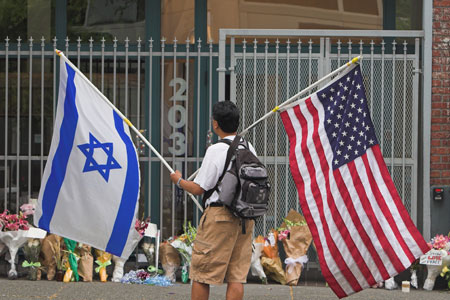
What brought about the persecution of the Jews under Hitler?
Adolf Hitler (who seemed to suspect his illegitimate grandfather might
have been Jewish) accused them of treachery and began a process of
discrimination against them.
Hitler blamed the Jews for fomenting communism, for corrupting Germany
through their manipulation of entertainment and the press, and for
using their hold on the economy for dishonest private gain.
Maybe Hitler, who came to believe in the superiority of the Aryan
(Germanic) race simply could not tolerate the Jews because they also
believed themselves a special race, chosen by God. The racial
superiority game cannot have two winners.
The only thing I still wonder is why -- with all this already apparent,
with Hitler already a Jew-hater and monster in the making -- the
Rothschild family chose to finance his takeover of the Weimar Republic.
Were they really that naïve? Or did they do it with a personal
long-range goal in mind?
Why did the Germans detain the Jews during World War II?
Right after Germany invaded Poland, on 5 September 1939, the Zionist
leader Chaim Weizmann declared war on Germany on behalf of the world’s
Jews: “The Jews stand by Great Britain and will fight on the side of
the democracies. . . . The Jewish Agency is ready to enter into
immediate arrangements for utilizing Jewish manpower, technical
ability, resources etc. . .”
From that point onward, the Germans considered all Jews enemy aliens and treated them accordingly.
What was the purpose of the detention camps?
Before Germany began its systematic detainment of the Jews, my native
country, Canada, had already detained its Japanese citizens -- even
though they declared themselves loyal to Canada and King George VI. The
camps, the Canadian government said, were for their own protection and
to avoid incidents. Australia, the United States and many other
countries took similar measures.
Although Germany never detained all of its Jewish population, it did
seize and detain those Jews the government considered at risk or
dangerous. At the plants they put them to work for the German war
industry -- the Buna rubber works at Bergen-Belsen, I. G. Farben
Industrie at Auschwitz, Siemens Electrical at Ravensbruck, etc.
What was the Germans’ Endlösung (Final Solution)?
Even before the outbreak of World War II the Germans had entered
negotiations with Great Britain and France to see about exporting its
unwanted Jewish population. Sending them to Palestine got considered
but all authorities (including the Germans) felt it would cause unrest
among the Palestinian Muslim and Christian population.
Various places in Africa and British overseas colonies got considered.
But most of the Jews that emigrated from Germany and Austria before
1939 (upwards of a million) moved west to America or east into the
Soviet Union.
The term Endlösung (final solution) was consistently used, in German
documents, as referring to the emigration/deportation of the Jews. That
it ever meant anything else, in code language, or double speech, is the
conjecture of post-war writers.
As late as May, 1944, one year before the final collapse of the Third
Reich, the German government sent a Jewish agent, Joel Brand, to the
Middle East to seek admission for a million Jews to Palestine. A
training centre for Jewish people, teaching them how to farm and care
for animals, existed in Austria to prepare them for that emigration.
How were conditions in the German camps?
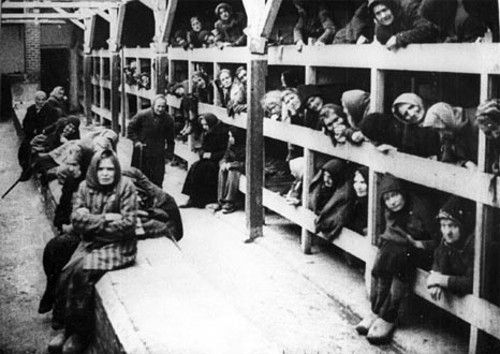
Corrie ten Boom, arrested for harbouring Jews in the German-occupied
Netherlands, told of her experiences in German detention camps. An
earnest Christian, motivated by her compassion for Jews and Germans
alike, Corrie’s description of the camps rings true -- even as it comes
through the words of her American biographers.
The accounts of Albert Keuter, a Mennonite pastor from Den Haag in the
Netherlands, and André de Croix, a Mennonite from Winschoten in the
Netherlands, both of whom died at Bergen-Belsen, match Corrie’s in
every respect. So do the accounts of all other believers held in the
camps during the war years.
Conditions in the camps were grim, cruel, often unreasonable, yet
amazingly rigid and orderly. Everything, down to Corrie’s few personal
possessions, got recorded, saved, processed in an orderly manner.
Undernourished prisoners kept dying continually of disease, daily abuse
and harrassment. Yet, oddly, in the light of later accounts, believing
prisoners did not report major interaction with Jewish people in the
camps. They did not witness any process of mass extermination.
I have heard the pros. I have heard the cons. I have seen the photos
and personally processed what evidence is available to the public in
America and Europe. Would it make you unhappy if I had to tell you that
so far I have not gotten convinced the German camps were the
extermination centres that many have made them to be?
Unlike in the camps of America's Soviet allies, where the ICRC
(International Committee of the Red Cross) was never permitted entry,
all German camps expected and facilitated the visits of Red Cross
officers -- all through the war. All camps, including the ones at
Auschwitz, remained open to visits of official delegations, the wives
and family members of the Germans that worked there, and detailed
accounts of their visits remain. The main railroad line from Vienna to
Krakow passed through the heart of the Auschwitz complex, exposing what
went on there to untold numbers of civilians and soldiers passing
through, right up to the end of the war.
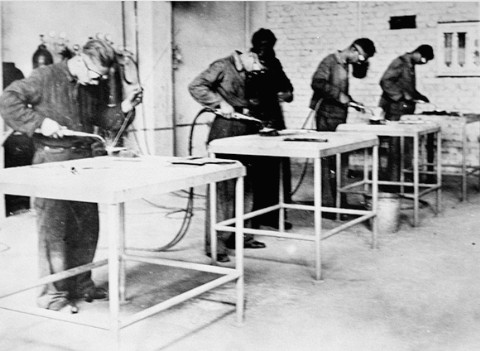
Camp inmates welding at Birkenau, Auschwitz, during the war. Large
numbers of prisoners had to be trained and supervised in skilled labour.
The last Red Cross inspection of the Auschwitz camps (including the
infamous one at Birkenau) took place in September, 1944. Red Cross
workers consistently reported conditions to be like Corrie ten Boom
described them -- regarding food, lodging, the distribution of personal
packages, hospital care -- until the last year of the war when a typhus
epidemic and increased Allied bombing made medical services and
adequate food rations impossible. It was during this time that the
emaciated bodies of those that died in the epidemic could no longer be
disposed of (the crematory ovens were not nearly big enough or fast
enough) and grisly photos were made of the sick and starving, or piles
of dead corpses waiting to get burned. Even during this time, Red Cross
workers commented on the efforts of German authorities to do what they
could for prisoners in distress.
Did the Germans operate special Death Camps?
Immediately after World War II reports began to circulate of Nazi Death
Camps -- places that existed only for the extermination of vast amounts
of people. No less than thirty, some said, existed in Germany and
Austria. Bergen-Belsen, Dachau, Mauthausen in Austria, Buchenwald,
Ravensbrück and many other camps originally appeared on this list. But
as Western troops and the people of West Germany cleaned up the camps
conflicting evidence began to appear and has continued to circulate to
this day.
Once again, I have heard the pros. I have heard the cons. I have seen
the “evidence” but this Orthodox Mennonite farmer was left with more
questions than answers.
The real Death Camps, it is now maintained, all operated in the east,
in what remained securely hidden behind the Iron Curtain for many years
after the war. Not some, not most, but all the evidence we have for
what happened at Auschwitz, at Treblinka, at Majdaneck and the rest of
the Death Camps, comes from Soviet sources. The way those places look
today, what is said and shown there, is what was left after the Soviets
opened them to the public.
My farmer's mind, as I strolled through the Holocaust Museum, looking
at all the photos, all the grisly displays, begged another question.
Auschwitz, obviously, was a massive industrial complex -- all surviving
photos proving that. Synthetic coal and rubber plants, the Krupp
armament works, an agricultural research station, laboratories,
facilities for stock breeding, etc. Why, if all these businesses
depended on captive labour, did hard-pressed camp authorities (under
the stress of ever higher quotas to meet and ever more desperate
shortages of ammunition and manufactured goods), persist in gassing and
burning such fantastically large numbers of their employees? Hundreds
and hundreds of thousands, millions of them, every year?
Who was left to run the plants? Who kept training this many replacements all the time?
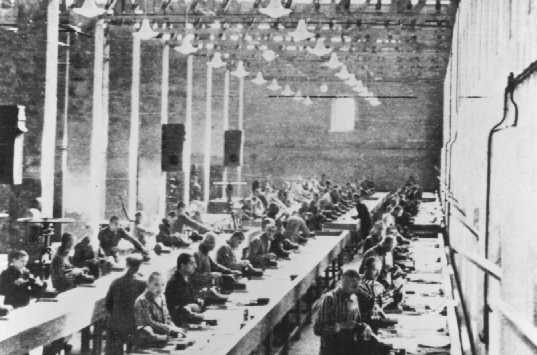
Siemens Electrical Plant in Auschwitz, during the war.
Why transport millions upon millions of people incredible distances,
through the heat of the battle for Europe by train, only to kill them
in elaborately complicated Death Camps (secret gas chambers
accommodating as many as 2000 people each, according to the Soviets)?
Why not simply kill them, as Marshall Tito did the Donau-Schwaben, on
the spot?
The Holocaust Museum gave me no answer.
Who saw the gas chambers and cremation ovens in use?
Kurt Gerstein saw them. A German prisoner in Paris, after the war, he
claimed to have infiltrated the ranks of the SS to see the secret gas
chambers and ovens firsthand -- in which forty million people, as Kurt
remembered it, were gassed and burned by the Nazis during the war
(later he reduced the number to twenty-five million).
Franz Stangl saw them. In fact, he was the commander of the infamous
Treblinka camp. In the confessions extracted from him in prison he
admitted to getting into Treblinka for the first time where “hundreds,
no, thousands of bodies lay about everywhere, putrefying, decomposing.”
And when he hopped off the train Franz remembers landing “knee deep in
money: I didn’t know which way to turn, which way to go. I waded in
paper notes, currency, precious stones, jewellery and clothes. They
were everywhere, strewn all over the square.” And on the other side of
the barbed wire fence, surrounding the camp were “the whores from
Warsaw, weaving drunk, dancing, singing, playing music.”
In the summer of 1944, one widely-accepted source reports no less than
300,000 Hungarian Jews gassed and cremated at Auschwitz during the
space of a few months. (This, in light of the fact that there don’t
seem to have been too many more Hungarian Jews, all told, before the
war, and not too many less, after the war, in Palestine, Russia, and
America.) Olga Lengyel, an Auschwitz survivor that died in New York in
2001, reports 17,280 Jews gassed daily at the camp, in 24-hour shifts.
That is, 720 people an hour, plus another eight thousand burned in the
death pits outside -- twenty-four thousand Jews per day through the
space of three years. (Go figure.)
continued in Part B...
-
Reply by Lev/Christopher on October 4, 2009 at 4:59am
-
-
|
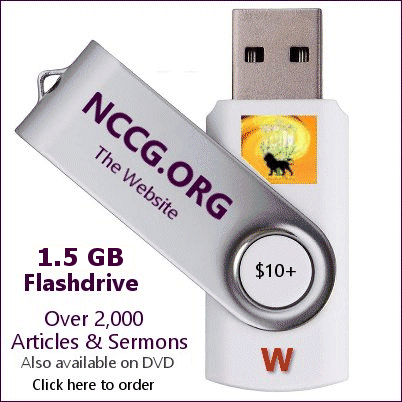

This page was created on 5 May 2010
Updated on 5 May 2010
Copyright © 1987-2010 NCCG - All Rights Reserved
|
|


